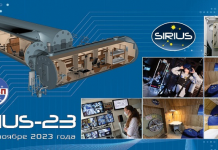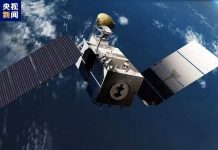Last updated on December 8th, 2022 at 03:14 pm
Roscosmos shared details about the Luna-25 mission six months before the launch
Six months later, in October, a Soyuz-2.1b carrier rocket will depart from the Vostochny cosmodrome, which will deliver the Luna-25 mission apparatus to the Earth’s natural satellite. He must make a difficult landing in the region of the Moon’s the South Pole. Landing on a natural satellite of the Earth should occur in Russian history for the first time since 1976. A new video on the Roscosmos channel is dedicated to this.

Unlike the Soviet missions, which envisaged landing at the equator, the new device, created according to the Luna-Glob project, was to land in a hard-to-reach area with difficult terrain – in the crater of Boguslavsky or Manzini. 8 cameras are installed onboard the device, which will broadcast all stages of the flight and landing and record circular panoramas from the surface.
It is planned that the automatic interplanetary station “Luna-25” will operate for at least one year, withstanding the conditions of the polar night at temperatures down to –170 ° C. The onboard thermoregulation system is based on a radioisotope generator with plutonium as an energy source.
The fueled landing vehicle weighs 1.75 tonnes, and its total payload weight is only 30 kg. Now the station and the scientific equipment located on it are undergoing electrical and radio technical tests. The framework of which the interaction with the Earth of all onboard equipment and control by radio communication is being worked out.
The mission’s main objective is to contact studies of the lunar regolith, dust and gas components, and the lunar exosphere. More than 25 Roscosmos organizations are involved in the scientific program. Experts hope to confirm that the ice trail visible from orbit is indeed water in a frozen state. The possibility of extracting this substance on the Moon is one of the key factors in further developing the Earth’s satellite and creating a habitable base on it.
With the help of a manipulator’s arm with a bucket, the lunar soil will be taken and delivered onboard – the drilling rigs are not used. All studies will be carried out on-site, for which unique instruments have been developed, including the Hadron-LR, whose detectors will measure the content of water and other elements in the regolith without contact.
A low concentration of ice is expected at the Luna-25 landing site. The next probe, Luna-26, will be orbiting, while Luna-27 will become a heavy automatic station for the deepest exploration of the Earth’s natural satellite. A high-precision landing will be performed within its framework in an area with richer water content in the lunar soil. Russian scientific groups are already actively creating instruments for this mission, such as a complex based on diode laser spectroscopy, which will be used for regolith pyrolysis.



